Reading: The Gilded Age
The Gilded Age

From the ashes of the American Civil War sprung an economic powerhouse.
The factories built by the Union to defeat the Confederacy were not shut down at the war's end. Now that the fighting was done, these factories were converted to peacetime purposes. Although industry had existed prior to the war, agriculture had represented the most significant portion of the American economy.
After the war, beginning with the railroads, small businesses grew larger and larger. By the century's end, the nation's economy was dominated by a few, very powerful individuals. In 1850, most Americans worked for themselves. By 1900, most Americans worked for an employer.
The growth was astounding. From the end ofRECONSTRUCTION in 1877 to the disastrous PANIC OF 1893, the American economy nearly doubled in size. New technologies and new ways of organizing business led a few individuals to the top. The competition was ruthless. Those who could not provide the best product at the cheapest price were simply driven into bankruptcy or were bought up by hungry, successful industrialists.
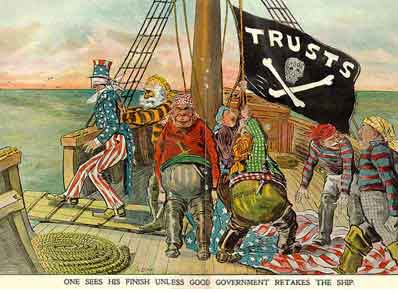
The so-called captains of industry became household names: John D. Rockefeller of Standard Oil, Andrew Carnegie of Carnegie Steel, and J. Pierpont Morgan, the powerful banker who controlled a great many industries. Their tactics were not always fair, but there were few laws regulating business conduct at that time.
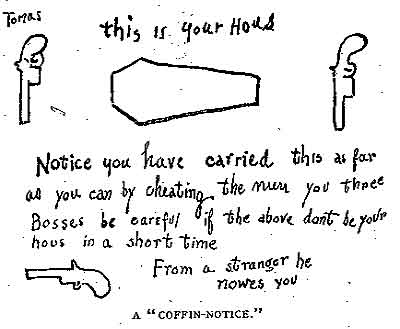
The "Molly Maguires" were a band of 19th century Irish immigrant laborers who struggled to survive in American industry. They organized labor unions and were not averse to violence, as this "coffin notice," delivered to three bosses, suggests.
Industrial Strength
Nevertheless, the American economy grew and grew. By 1914, the small nation once seen as a playground for European empires had now surpassed them all. The United States had become the largest industrial nation in the world.
However, the prosperity of America did not reach everyone. Amid the fabulous wealth of the new economic elite was tremendous poverty. How did some manage to be so successful while others struggled to put food on the table? Americans wrestled with this great question as new attitudes toward wealth began to emerge.
What role did the government play in this trend? Basically, it was pro-business. Congress, the Presidents, and the Courts looked favorably on this new growth. But leadership was generally lacking on the political level.CORRUPTION spread like a plague through the city, state, and national governments. Greedy legislators and "forgettable" Presidents dominated the political scene.
True leadership, for better or for worse, resided among the magnates who dominated the Gilded Age.
Binding the Nation by Rail
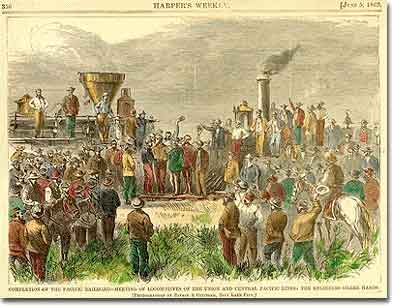
The transcontinental railway was completed with a jubilant celebration on May 10, 1869, when the rails connecting the Central Pacific and Union Pacific Railroads were joined at Promontory, Utah.
The LOCOMOTIVE was not an invention of the GILDED AGE. Indeed Americans had traveled by rail in the decades that preceded the Civil War. But such travel was risky.
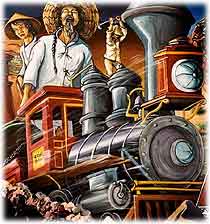
Passengers often sat in the same room as a wood burner and had to be watchful of wayward sparks landing on their clothing. Braking systems were not always trustworthy. Several engines even exploded while trying to reach a destination.
Traveling also represented a tremendous investment in time. Rail passengers often had to change trains frequently because the width between tracks varied from company to company. Such a journey could be uncomfortable, boring, and dangerous.
Give Me a Brake
After the Civil War many rail problems were solved. GEORGE WESTINGHOUSEinvented the air brake and trains could stop more reliably as a result. Railroad firms agreed on a standard width between tracks to reduce transfers. ThePULLMAN CAR COMPANY produced sleeper cars and dining cars to make travel more comfortable.
The Transcontinental Railroad
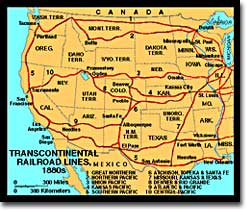
Map of Transcontinental Railroad Lines, 1880s
Soon after the railroad made its appearance in the U.S. in the 1830s, Americans dreamed of linking the Atlantic and Pacific Oceans by rail. ATRANSCONTINENTAL RAILROADwould allow for settlement of the west, open new markets for eastern manufacturers, and bring relief to overcrowded eastern cities.
Some even believed that it was divinely intended that Americans should control the whole of the continental U.S. In 1845, a Democratic journalist named JOHN L. O'SULLIVAN coined the phrase "MANIFEST DESTINY."
Manifest Destiny
"... the right of our manifest destiny to over spread and to possess the whole of the continent which Providence has given us for the development of the great experiment of liberty and federaltive development of self government entrusted to us....
Steaming locomotives would hasten western settlement, spread democratic values, and increase the size of the United States (Arizona, Oklahoma, New Mexico etc., were not yet states, only TERRITORIES). Western SETTLEMENT was a paramount national interest. As such, the federal government awarded the contract to link the coasts by rail to two companies, the UNION PACIFIC and the CENTRAL PACIFIC.
I've Been Working on the Railroad
Union Pacific workers, many of whom were Irish and Chinese immigrants, started at Omaha, Nebraska, and hammered their way westward. From Sacramento, California, the Central Pacific made its way eastward with the assistance of thousands of Chinese immigrants.
Those working on the railroad gave their sweat and sometimes their lives blasting through the often unforgiving terrain. Other dangers that workers faced were disease, searing summer heat, freezing temperatures in the mountains, Native American raids and the lawlessness and violence of pioneer towns.
The Golden Spike
The government declared that the two lines would merge at PROMONTORY SUMMIT near Ogden, Utah. On May 10, 1869, LELAND STANFORD, representing the Central Pacific Railroad, was provided the honor to hammer a golden spike into the ground that marked the completion of the coast-to-coast line. Celebrations erupted across the land. Even the Liberty Bell tolled once again to commemorate the occasion.
Soon, other transcontinental lines were constructed and travel across the continent became worlds simpler, less expensive, and much faster, than by the old Conestoga wagon.
On the Right Track
The engineering achievement was monumental. The costs of the operation to railroads were enormous. Tens of thousands of workers had to be paid, sheltered, and fed. Tons of steel and wood were required.
However, the economic incentives to railroads were enormus. The government offered generous loans to companies who were willing to assume the risk. The greatest reward was land. For each mile of track laid by the Central and Union Pacific Railroads, the companies received 640 acres of public land. In other rail projects, state governments often kicked in additional acres for a growing number of rail companies.
The Interstate Commerce Commission
All in all, the railroads received nearly 200 million acres of land from the U.S. government for fulfilling contracts. Directors of some railroads made fortunes. Foremost among the RAILROAD TYCOONS were CORNELIUS VANDERBILT, JAMES J. HILL, and JAY GOULD.
But freight railroad abuses grew rampant. Money lined the pockets of greedy public officials who awarded generous terms to the railroads. Railroad companies set their own shipping rates.
Sometimes it was more expensive for a small farmer to ship goods to a nearby town than to a faraway city. Because the companies kept their rates secret, one farmer could be charged more than another for the same freight transport.
To reduce competition, railroad companies established pools. These were informal arrangements between companies to keep rates above a certain level. Consequently, the public suffered. Finally, in 1887, Congress responded to public outcry by creating the INTERSTATE COMMERCE COMMISSION to watch over the rail industry. This was the nation's first REGULATORY AGENCY. Due to inconcise wording in its enabling legislation, the ICC was largely ignored until the early 20th century.
But the public also reaped great benefits. Eastern businessmen could now sell their goods to California citizens. As a result of improved transportation all Americans had access to more goods at a cheaper price. The westward movement was greatly accelerated. Those seeking a new start in life could much more easily "go west.".
No industrial revolution can occur without a transport web. The nation was now bound together by this enormous network and its citizens were ready to reap the rewards.
The New Tycoons: John D. Rockefeller
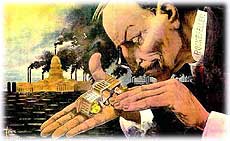
"What a Funny Little Government!" Cartoonist Horace Taylor pokes fun at John D. Rockefeller in this cartoon which appeared in The Verdict, a partisan magazine of the day.
He was America's first billionaire.
In a pure sense, the goal of any capitalist is to make money. AndJOHN D. ROCKEFELLER could serve as the poster child for CAPITALISM. Overcoming humble beginnings, Rockefeller had the vision and the drive to become the richest person in America.
At the turn of the century, when the average worker earned $8 to $10 per week, Rockefeller was worth millions.
Robber Baron or Captain of Industry?
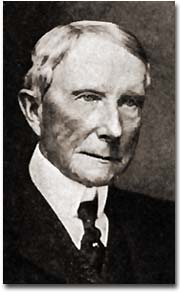
John D. Rockefeller (1839-1937)
What was his secret? Is he to be placed on a pedestal for others as a "CAPTAIN OF INDUSTRY?" Or should he be demonized as a "robber baron." A ROBBER BARON, by definition, was an American capitalist at the turn of the 19th century who enriched himself upon the sweat of others, exploited natural resources, or possessed unfair government influence.
Whatever conclusions can be drawn, Rockefeller's impact on the American economy demands recognition.
Rockefeller was born in 1839 in Moravia, a small town in western New York. His father practiced herbal medicine, professing to cure patients with remedies he had created from plants in the area. John's mother instilled a devout Baptist faith in the boy, a belief system he took to his grave. After being graduated from high school in 1855, the family sent him to a Cleveland business school.
Young John Rockefeller entered the workforce on the bottom rung of the ladder as a clerk in a Cleveland shipping firm. Always thrifty, he saved enough money to start his own business in produce sales. When the Civil War came, the demand for his goods increased dramatically, and Rockefeller found himself amassing a small fortune.
He took advantage of the loophole in the Union draft law by purchasing a substitute to avoid military service. When EDWIN DRAKE discovered oil in 1859 in Titusville, Pennsylvania, Rockefeller saw the future. He slowly sold off his other interests and became convinced that refining oil would bring him great wealth.
Waste Not...
Rockefeller introduced techniques that totally reshaped the OIL INDUSTRY. In the mid-19th century, the chief demand was for kerosene. In the refining process, there are many by-products when CRUDE OIL is converted toKEROSENE. What others saw as waste, Rockefeller saw as gold. He sold one byproduct paraffin to candlemakers and another byproduct petroleum jelly to medical supply companies. He even sold off other "waste" as paving materials for roads. He shipped so many goods that railroad companies drooled over the prospect of getting his business.
Rockefeller demanded REBATES, or discounted rates, from the railroads. He used all these methods to reduce the price of oil to his consumers. His profits soared and his competitors were crushed one by one. Rockefeller forced smaller companies to surrender their stock to his control.
Standard Oil — a Trust-worthy Company?
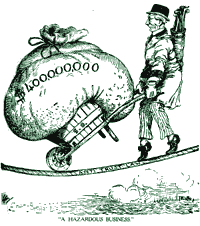
John D. Rockefeller had to perform a delicate balancing act to maintain his reputation as a philanthropist while living the live of a wealthy businessman.
This sort of arrangement is called a trust. A TRUST is a combination of firms formed by legal agreement. Trusts often reduce fair business competition. As a result of Rockefeller's shrewd business practices, his large corporation, the STANDARD OIL COMPANY, became the largest business in the land.
As the new century dawned, Rockefeller's investments mushroomed. With the advent of the automobile, gasoline replaced kerosene as the number one petroleum product. Rockefeller was a bona fide billionaire. Critics charged that his labor practices were unfair. Employees pointed out that he could have paid his workers a fairer wage and settled for being a half-billionaire.
Before his death in 1937, Rockefeller gave away nearly half of his fortune. Churches, medical foundations, universities, and centers for the arts received hefty sums of oil money. Whether he was driven by good will, conscience, or his devout faith in God is unknown. Regardless, he became a hero to many enterprising Americans.
The New Tycoons: Andrew Carnegie
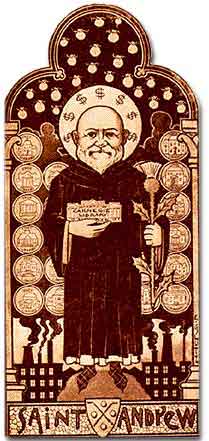
By the time he died in 1919, Carnegie had given away $350,695,653. At his death, the last $30,000,000 was likewise given away to foundations, charities and to pensioners.
Oil was not the only commodity in great demand during the Gilded Age. The nation also needed steel.
The railroads needed STEEL for their rails and cars, the navy needed steel for its new naval fleet, and cities needed steel to build skyscrapers. Every factory in America needed steel for their physical plant and machinery. Andrew Carnegie saw this demand and seized the moment.
Humble Roots
Like John Rockefeller, ANDREW CARNEGIEwas not born into wealth. When he was 13, his family came to the United States from Scotland and settled in Allegheny, Pennsylvania, a small town near Pittsburgh. His first job was in a cotton mill, where he earned $1.20 per week.
His talents were soon recognized and Carnegie found himself promoted to the bookkeeping side of the business. An avid reader, Carnegie spent his Saturdays in the homes of wealthy citizens who were gracious enough to allow him access to their private libraries. After becoming a telegrapher for a short while, he met the head of a railroad company who asked his services as a personal secretary.
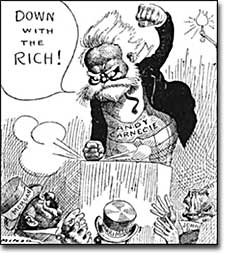
Millionaire Andrew Carnegie spoke against irresponsibility of the wealthy and sharply criticized ostentatious living.
During the Civil War, this man,THOMAS SCOTT, was sent to Washington to operate transportation for the Union Army. Carnegie spent his war days helping the soldiers get where they needed to be and by helping the wounded get to hospitals. By this time, he had amassed a small sum of money, which he quickly invested. Soon iron and steel caught his attention, and he was on his way to creating the largest steel company in the world.
Vertical Integration: Moving on Up
The Bessemer Process
When WILLIAM KELLY and HENRY BESSEMER perfected a process to convert iron to steel cheaply and efficiently, the industry was soon to blossom.
Carnegie became a tycoon because of shrewd business tactics. Rockefeller often bought other oil companies to eliminate competition. This is a process known as HORIZONTAL INTEGRATION. Carnegie also created a VERTICAL COMBINATION, an idea first implemented by GUSTAVUS SWIFT. He bought railroad companies and iron mines. If he owned the rails and the mines, he could reduce his costs and produce cheaper steel.
Carnegie was a good judge of talent. His assistant, HENRY CLAY FRICK, helped manage the CARNEGIE STEEL COMPANY on its way to success. Carnegie also wanted productive workers. He wanted them to feel that they had a vested interest in company prosperity so he initiated a profit-sharing plan.
All these tactics made the Carnegie Steel Company a multi-million dollar corporation. In 1901, he sold his interests to J.P. Morgan, who paid him 500 million dollars to create U.S. Steel.
Giving Back
Retirement did not take him out of the public sphere. Before his death he donated more than $350 million dollars to public foundations. Remembering the difficulty of finding suitable books as a youth, he helped build three thousand libraries. He built schools such as CARNEGIE-MELLON UNIVERSITY and gave his money for artistic pursuits such as CARNEGIE HALL in New York.
Andrew Carnegie was also dedicated to peace initiatives throughout the world because of his passionate hatred for war. Like Rockefeller, critics labeled him a robber baron who could have used his vast fortunes to increase the wages of his employees. Carnegie believed that such spending was wasteful and temporary, but foundations would last forever. Regardless, he helped build an empire that led the United States to world power status.
The New Tycoons: J. Pierpont Morgan
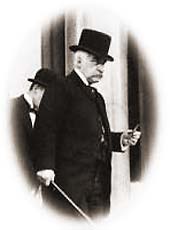
J.P. Morgan invested in everything from Thomas Edison's electric company to railroads and steel companies to insurance firms.
Child of Privilege
Not all of the tycoons of the Gilded Age were rags-to-riches stories. J. PIERPONT MORGAN was born into a family of great wealth. His father had already made a name for himself in the banking industry. With Morgan's family resources, he enjoyed the finest business education money could buy.
He did not scratch and claw his way to the top of any corporate ladder. His father arranged for an executive track position at one of New York's finest banks. Regardless of his family's advantages, Morgan had a great mind of his own. He set out to conquer the financial world, and conquer it he did.
Morgan the Banker
Morgan's first business ventures were in banking. By 1860, he had already established his own foreign exchange office. He knew the power of investment. Not content to control just the banking industry, he bought many smaller ventures to make money.
During the Civil War, he paid the legally allowed fee to purchase a substitute soldier and evaded military service. Morgan made handsome profits by providing war materials. One of his enterprises sold defective rifles to the Union army. Upon later investigations, he was declared ignorant of the poor quality of his guns and was cleared of all charges.
After the war, he set out to corner the nation's financial markets. When the Panic of 1873 rocked the nation's economy, Morgan protected himself wisely and emerged in the aftermath as the king of American finance.
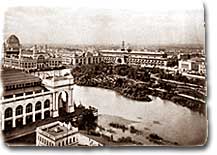
J.P. Morgan was one of the organizers of the World Fair held in Chicago in 1893.
Despite his label as a robber baron, Morgan felt his investments benefited America. His railroad dealings helped consolidate many smaller, mismanaged firms, resulting in shorter trips and more dependable service. Two times during financial panics he allowed the federal government to purchase his vast gold supplies to stop the spiral of deflation.
He owned a bridge company and a tubing company. His most renowned purchase was in 1901, when he bought the Carnegie Steel Company for $500 million to create U.S. Steel. Within ten years U.S. Steel was worth over a billion dollars.
Morgan's actions marked a shift in thinking among American industrialists. He proved that it was not necessary to be a builder to be successful. Smart investment and efficient consolidation could yield massive profits. YoungENTREPRENEURS shifted their goals to banking in the hopes of mirroring Morgan's success.
Trouble with the Government
For all his accomplishments, he was harshly criticized. The first decade of the twentieth century brought challenges to Morgan from the government. HisNORTHERN SECURITIES RAILROAD company was deemed illegal under federalANTITRUST LAW, the first such action by the national government. He was investigated by Congress for his control of the financial markets. Even U.S. Steel was forced to relinquish its MONOPOLY.
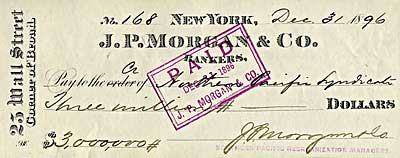
Things you don't see everyday: A cancelled check for three million dollars from J.P. Morgan to the Northern Pacific Syndicate.
Jaded by the criticism, Morgan moved to Europe, where he lived his final days. He was a favorite target of intellectuals who claimed that such tycoons robbed the poor of their deserved wealth. He was a hero to enterprising financiers across the land who dreamed of following his example. That is, of course, unless they were destroyed by his shrewd, fierce tactics.
New Attitudes Toward Wealth
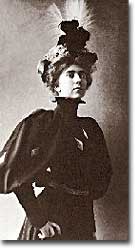
Social Darwinism fueled the popularity of "Friendly visitors" in the field of social work. These upper class women believed it was their Christian duty to help poverty stricken by providing positive moral role models.
Not everybody was getting rich. The new wealthy class, although more prominent, larger, and richer than any class in American history, was still rather small.
People soon began to ask fundamental questions. How did one get rich in America? Was it because of a combination of hard work and intelligence? Was it because of inheritance? Did education and skill play a role? Or was it simply luck?
Old attitudes about the importance of inheritance were still prevalent, but new ideas also emerged. Among the most popular were Social Darwinism, the Gospel of Wealth, and Algerism.
Surivival of the Fittest
When a popular conception of "SURVIVAL OF THE FITTEST" grew from CHARLES DARWIN's idea of the process of NATURAL SELECTION in the wild, the world was forever changed. Church leaders condemned him as a heretic, and ordinary people everywhere cringed at the idea that humans may have evolved from apes. It was inevitable that intellectuals would soon point Darwin's concepts at human society.
These SOCIAL DARWINISTS, led by HERBERT SPENCER and WILLIAM GRAHAM SUMNER, believed that the humans who were the most fit became the most successful. Whatever people had the necessary skills to prosper — perhaps talent, brains, or hard work — would be the ones who would rise to the top. Why were some people poor? To the Social Darwinist, the answer was obvious. They simply did not have the required skills.
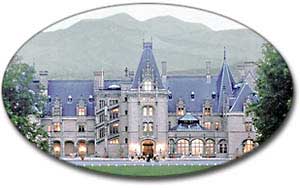
Biltmore Estate in Asheville, North Carolina
Social Darwinists went further in their application of Darwin. Darwin stated that the weaker members of a species in nature would die and that over time only the stronger genes would be passed on. Social Darwinists believed the same should happen with humans. They opposed government handouts, or safety regulations, or laws restricting child labor. Such actions would coddle the weak, and the unfit would be allowed to survive.
Gospel of Wealth
Some Americans tried to reconcile their Christian beliefs with Social Darwinism. Because the Church had been such an opponent of Darwin's ideas, it was difficult for religious folks to accept Social Darwinism.
Andrew Carnegie and John Rockefeller both agreed that the most successful people were the ones with the necessary skills. But they each believed that God played a role in deciding who got the skills.
Because God granted a select few with the talent to be successful, Christian virtue demanded that some of that money be shared. This is where the difference lies between the hardcore Social Darwinist and the proponent of the GOSPEL OF WEALTH. Carnegie and Rockefeller became philanthropists — wealthy citizens who donated large sums of money for the public good.
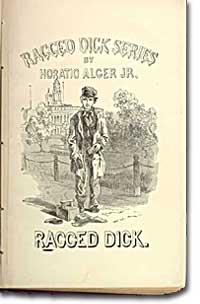
Horatio Alger wrote popular rags-to-riches novels, such as Ragged Dick; or, Street Life in New York. Many of these books were written as an example to young boys, teaching that the virtues of hard work would eventually pay off.
Horatio Alger's American Dream
A third influence American thinking wasHORATIO ALGER. Alger was not an intellectual; rather, he wrote DIME NOVELSfor the hordes of immigrant masses rushing to America's shores. Although he penned many stories, each book answered the question of how to get rich in America. Alger believed that a combination of hard work and good fortune — pluck and luck, in his words — was the key.
A typical Alger story would revolve around a hardworking immigrant who served on the bottom rung of the corporate ladder, perhaps as a stock boy. One day he would be walking down the street and see a safe falling from a tall building. Our hero would bravely push aside the hapless young woman walking below and save her life. Of course, she was the boss's daughter. The two would get married, and he would become vice-president of the corporation.
This is what the masses wished to believe. Success would not come to a select few based on nature or divine intervention. Anyone who worked hard could make it in America if they caught a lucky break. This idea is the basis for the "AMERICAN DREAM."
Is Alger's dream a reality or just folklore? There simply is no answer. Thousands of Americans have found this idyllic path, but as many or more have not.
Politics of the Gilded Age
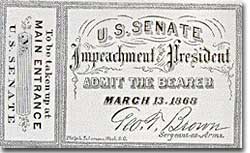
Impeachment trial ticket
The Gilded Age will be remembered for the accomplishments of thousands of American thinkers, inventors, entrepreneurs, writers, and promoters of social justice. Few politicians had an impact on the tremendous change transforming America. The Presidency was at an all-time low in power and influence, and the Congress was rife with corruption. State and city leaders shared in the graft, and the public was kept largely unaware. Much like in the colonial days, Americans were not taking their orders from the top; rather, they were building a new society from its foundation.
The American Presidents who resided in the White House from the end of the Civil War until the 1890s are sometimes called "THE FORGETTABLE PRESIDENTS." A case-by-case study helps illustrates this point.
ANDREW JOHNSON was so hated he was impeached and would have been removed from office were it not for a single Senate vote.
A Soldier in the White House
ULYSSES S. GRANT was a war hero but was unprepared for public office. He had not held a single elected office prior to the Presidency and was totally naive to the workings of Washington. He relied heavily on the advice of insiders who were stealing public money. His secretary of war sold Indian land to investors and pocketed public money. His private secretary worked with officials in the Treasury Department to steal money raised from the tax on whiskey.
Many members of his Administration were implicated in the CRÉDIT MOBILIER SCANDAL, which defrauded the American public of common land. Grant himself seemed above these scandals, but lacked the political skill to control his staff or replace them with officers of integrity.
Electoral Woes
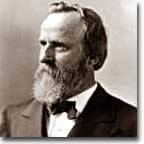
Rutherford B. Hayes was elected in 1876 by a margin of one electoral vote.
His successor was RUTHERFORD B. HAYES. Hayes himself had tremendous integrity, but his Presidency was weakened by the means of his election. After the electoral votes were counted, his opponent, SAMUEL TILDEN, already claimed a majority of the popular vote and needed just one electoral vote to win. Hayes needed twenty. Precisely twenty electoral votes were in dispute because the states submitted double returns — one proclaiming Hayes the victor, the other Tilden. A Republican-biased electoral commission awarded all 20 electoral votes to the Republican Hayes, and he won by just one electoral vote.
While he was able to claim the White House, many considered his election a fraud, and his power to rule was diminished.
Assassination
JAMES GARFIELD succeeded Hayes to the Presidency. After only four months, his life was cut short by an assassin's bullet. CHARLES GUITEAU, the killer, was so upset with Garfield for overlooking him for a political job that he shot the President in cold blood on the platform of the Baltimore and Potomac train station.
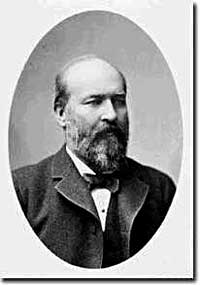
James A. Garfield
Vice-President CHESTER ARTHUR became the next leader. Although his political history was largely composed of appointments of friends, the tragedy that befell his predecessor led him to believe that the system had gone bad. He signed into law the PENDLETON CIVIL SERVICE ACT, which opened many jobs to competitive exam rather than political connections. The Republican Party rewarded him by refusing his nomination for the Presidency in 1884.
One President impeached, one President drowning in corruption, one President elected by possible fraud, one President assassinated, and one disgraced by his own party for doing what he thought was right. Clearly this was not a good time in Presidential history.
Congressional Supremacy
This was an era of CONGRESSIONAL SUPREMACY. The REPUBLICAN PARTYdominated the Presidency and the Congress for most of these years. Both houses of Congress were full of representatives owned by big business.
Laws regulating campaigns were minimal and big money bought a government that would not interfere. Similar conditions existed in the states. City governments were dominated by political machines. Members of a small network gained power and used the public treasury to stay in power — and grow fabulously rich in the process.
Not until the dawn of the 20th century would serious attempts be made to correct the abuses of Gilded Age government.
